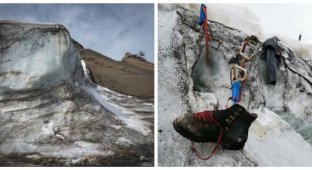The oldest European (7 photos)
On September 19, 1991, during a hike in the Ötztal Valley, German tourists Eric and Helmut Simon came across what they initially thought was the body of a recently deceased mountaineer. The remains belonged to a man who lived approximately 5,300 years ago - the oldest known representative of the Old World. The discovery became a real sensation, and the scientific research resembles a detective story.
In this guise, the Tyrolean Iceman greets visitors to the exhibition dedicated to him. Photo: © Jens Büttner/ DPA/ TASS 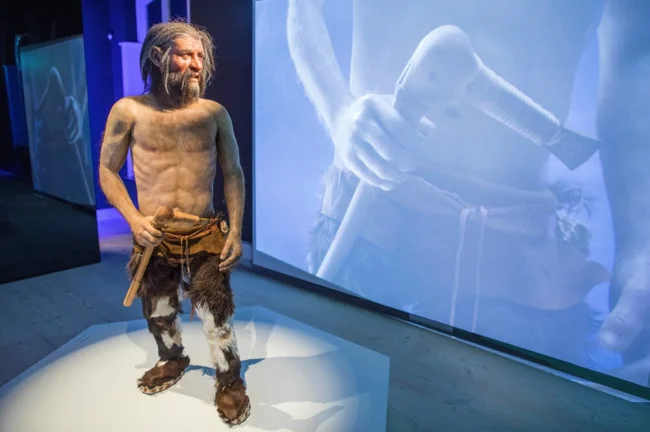
On September 19, 1991, during a hike in the Ötztal Valley, German tourists Eric and Helmut Simon came across what they initially took to be the body of a recently deceased mountaineer. The remains belonged to a person who lived approximately 5,300 years ago - this is the oldest known representative of the Old World. The discovery became a real sensation, and the scientific research is similar to a detective story.
The mummy that was found is now called Ötzi, after the valley. The body was very well preserved due to natural freezing. A jackhammer was even needed to pull it out of the ice trap. A monument was later erected on this spot.
A stone monument at the site of the discovery of the oldest inhabitant of Europe. Photo: © Matthias Röder/ dpa/picture-alliance/ TASS 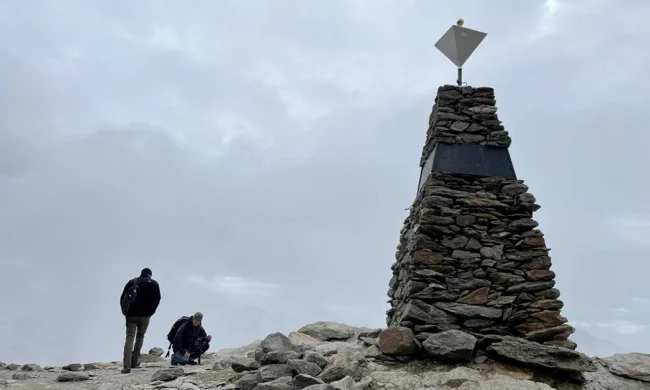
Scientists have found out where the "ice man" Ötzi came from to the place of his death in the Ötztal Alps. This was established by analyzing the moss in his intestines and samples taken from the ice nearby.
Specialists from the University of Glasgow have found out what the last path of the "Ice Man" Ötzi was - he came from the Schnalstal Valley to Ötztal, where he died from his wounds. This was established by moss samples in the ice where his body was, as well as in the gastrointestinal tract. The results of the study were published in the journal PLOS ONE.
Portrait
At the time of his death, Ötzi was about 45 years old. He was a short man, about 160 cm, weighed about 50 kg and wore more than 60 tattoos on his body - stripes and crosses. Moreover, they were done in an interesting way - instead of the paints or ink that are familiar to modern people, which are introduced under the skin with a needle, ancient people used soot. It was rubbed into the skin in places of cuts or punctures.
Obviously, tattoos in those days were not made for beautyPhoto: © 2015 Elsevier Masson 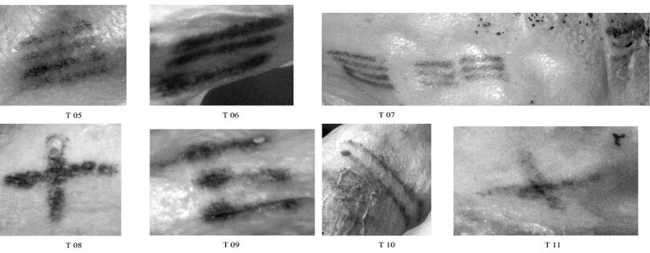
I read somewhere that this method was used by the inhabitants of Polynesia a century or two ago.
The contents of Otzi's rectum showed that he ate meat - he hunted chamois and deer. He also ate bran (apparently, something like bread), roots and fruits. By the time of his death, his teeth were very worn out. And in the hair of the ancient man, scientists found particles of copper (Otzi lived in the century of the same name), apparently, he was engaged in the production of this metal.
The Tyrolean Iceman, as he is also called, was probably a mountain shepherd. He was well equipped for this job. A well-preserved copper axe, a large bow [1.82 m] with arrows in a quiver, and a stone knife with a wooden handle were found next to the mummy. In Oetzi's bag were two types of mushrooms: he used one for kindling, the other as a medicine (it has antibacterial properties).
The shepherd's clothes matched the weather. On his head was a bearskin cap, on his body was something like a sheepskin coat and leggings made of goatskin, on his feet were leather moccasins, over which were worn fur-lined shoes (possibly snowshoes).
Reconstruction of Ötzi's bag and a modern backpackPhoto: © Klaus-Dietmar Gabbert/ dpa/picture-alliance/ TASS 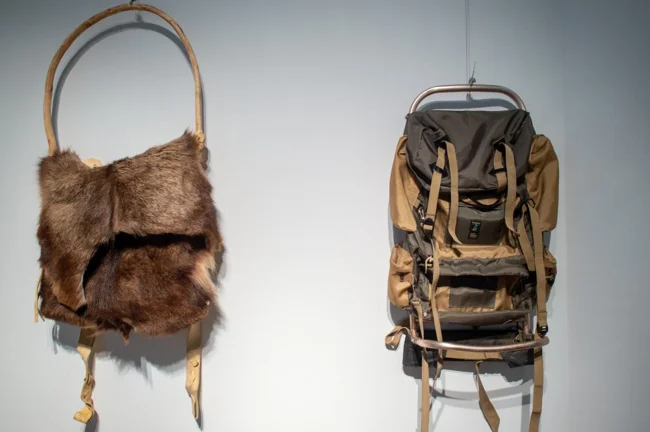
Origin
A large exhibition is dedicated to Ötzi in the Archaeology Museum of the Italian city of Bolzano, where Ötzi's remains are kept. There is also a statue of a shepherd, depicting him as a fair-skinned elderly man with long, blond hair, streaked with gray. This image of the steppe dweller was reconstructed based on genetic studies of the mummy in 2012.
Otzi lived a long life for his timePhoto: © Zigres/ Shutterstock/ FOTODOM 
However, modern sequencing (the quality of genetic research has improved significantly over the past 10 years) has shown that the Iceman was much darker than previously thought. Skin pigmentation markers showed a significant content of melanin - in other words, Otzi's skin was darker than that of modern Sicilians.
The Iceman did not have a lush "museum" head of hair. A marker characteristic of male pattern baldness was found in his genome. This is not surprising - at 45 years old, Otzi was considered an old man at that time.
In Otzi's mummy, blood cells were miraculously preserved in almost the same form as they are in modern people. And these are the most ancient human blood cells available today.
The version about Otzi's steppe origin, which many scientists doubted, was also refuted. Anatolian roots were found in the genome of the ancient European - this is the Asian territory of modern Turkey, from where local farmers came to the Old World (although then it was probably New for them), where they mixed with the local hunter-gatherers. Our hero, however, had little European DNA - apparently, his community lived in isolation, which is not uncommon for the high-altitude Alpine region.
Death
No matter how isolated Oetzi and his close people lived, they apparently had conflicts with their neighbors. The fact is that the ancient shepherd did not die a natural death in the mountains. Today, murder is the main version of his death.
The Tyrolean Iceman died in this unnatural posePhoto: © Klaus-Dietmar Gabbert/ dpa/picture-alliance/ TASS 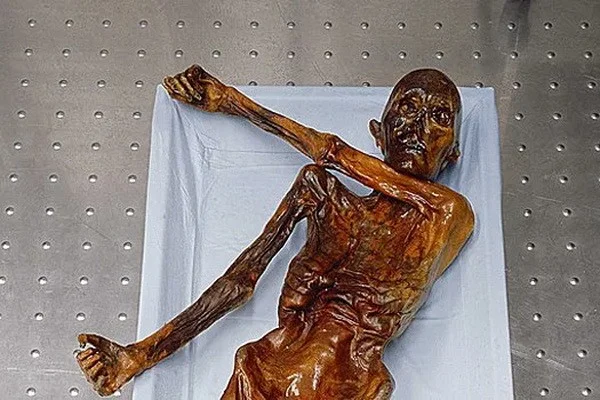
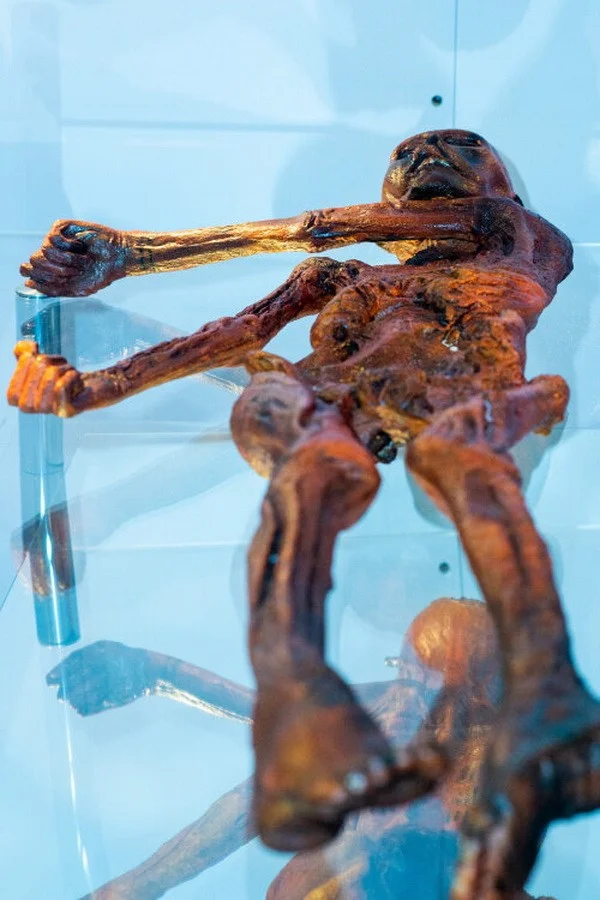
Although it was initially believed that he simply froze during a snowstorm that raged in late spring. But in 2001, scientists examined the mummy using X-rays and CT and discovered an arrowhead in his left shoulder. In addition, they recorded a head injury, as well as bruises and cuts on Otzi's hands, arms and chest. Apparently, he died from blood loss. The body was found face down with an unnaturally bent arm, apparently the man tried to get the arrowhead out of his shoulder until the last moment.
A DNA test done in 2003 showed that there was blood from four people on the shepherd's body and clothes. One type was found on his stone knife, two at once - on one of the arrows, the fourth - on his clothes. Probably, shortly before his death, Otzi and his fellow tribesman had a conflict (maybe more than one) with some people. Then the shepherd stabbed someone with a knife, and hit two others with a bow. During the fight, his partner was wounded, and then he carried him on himself, hence the traces of blood on his clothes.
Otzi's detective story continues. The more technology progresses, the more we will be able to learn about this amazing man and his fate.












